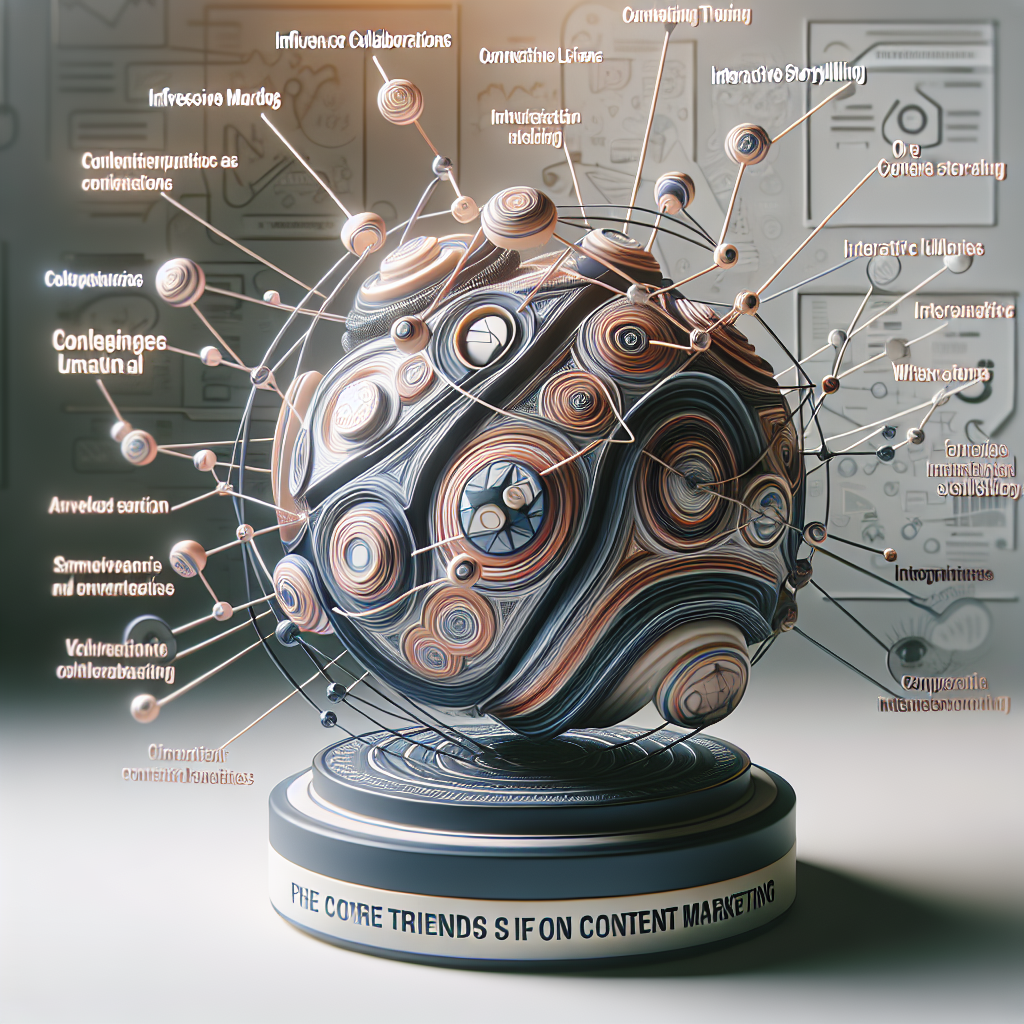Content Marketing Trends
Looking to stay ahead of the curve in the world of content marketing? Look no further! In this article, we’ll explore the latest content marketing trends that can help elevate your digital strategies and drive business growth. From the ins and outs of search engine optimization (SEO), search engine marketing (SEM), and social media marketing, to email marketing, digital analytics, e-commerce marketing, and influencer collaborations – we’ve got you covered. Whether you’re seeking to improve your blog content strategy, optimize your online store, or enhance your email campaigns, these trends will equip you with the tools and techniques you need to succeed. So, let’s dive into the fascinating world of content marketing and uncover the key trends that are shaping the industry today!
Content Marketing
Content marketing is a strategic approach to marketing that focuses on creating and distributing valuable, relevant, and consistent content to attract and engage a clearly defined audience. It involves the creation and sharing of online material such as articles, blog posts, videos, infographics, and social media content to ultimately drive profitable customer action.
Content Marketing Trends
In the ever-evolving digital landscape, it’s crucial to stay updated with the latest content marketing trends to ensure your strategy remains effective and impactful. Some key trends in content marketing include:
-
Video Content: The popularity of video content continues to rise, with more and more brands leveraging videos to engage their audience. From product demos to storytelling videos, incorporating video content in your strategy can significantly boost your brand’s visibility.
-
User-Generated Content: User-generated content (UGC) refers to content created by your audience or customers. It can include testimonials, reviews, social media posts, and more. UGC is highly valuable as it builds trust, authenticity, and social proof for your brand.
-
Interactive Content: With the increasing demand for personalized experiences, interactive content such as quizzes, polls, surveys, and calculators has become a powerful engagement tool. Interactive content encourages audience participation and enables you to gather valuable data about your target audience.
-
Voice Search Optimization: With the rise of voice-activated devices and virtual assistants, optimizing your content for voice search is essential. Consider incorporating long-tail keywords and conversational language to align your content with voice search queries.
Importance of Content Marketing
Content marketing plays a crucial role in the success of any digital marketing strategy. Here are some key reasons why content marketing is important:
-
Building Brand Awareness: When you consistently create and distribute valuable content, you increase your brand’s visibility and build awareness among your target audience. By providing educational and informative content, you position your brand as a trusted authority in your industry.
-
Driving Organic Traffic: Quality content optimized for search engines can generate organic traffic to your website. By focusing on relevant keywords and providing valuable information, you increase the chances of appearing in search engine results, leading to higher website visibility and traffic.
-
Generating Leads and Conversions: Content marketing is an effective lead generation and conversion strategy. By offering valuable content in exchange for contact information, such as email addresses, you can build a database of leads to nurture and convert into paying customers.
-
Building Customer Loyalty: Delivering consistent, valuable content helps establish a deep connection with your audience. By addressing their pain points, providing solutions, and nurturing the relationship through ongoing content, you can build trust and loyalty among your customers.
Benefits of Content Marketing
Content marketing offers a range of benefits that can contribute to the growth and success of your business. Some key benefits include:
-
Cost-Effective: Compared to traditional advertising methods, content marketing is often more cost-effective. By creating and distributing content online, you can reach a wide audience without significant financial investment.
-
Increased Engagement: Valuable and relevant content engages your audience, encouraging them to interact, share, and comment on your content. This engagement helps build a community around your brand and fosters a sense of loyalty and trust.
-
Improved Search Engine Rankings: When you consistently produce high-quality content that aligns with your target audience’s search intent, search engines recognize the relevance and value of your website. This can lead to improved search engine rankings, driving more organic traffic to your site.
-
Long-Lasting Impact: Unlike traditional advertising, content marketing has a long-lasting impact. Well-crafted and evergreen content can continue to attract and engage your audience for months or even years after its initial creation, providing ongoing value and exposure for your brand.
Content Marketing Strategy
A well-defined content marketing strategy is essential to ensure your efforts are focused, cohesive, and effective. Here are some key components to consider when developing your content marketing strategy:
Defining Goals and Objectives
Before diving into content creation, it’s crucial to define clear goals and objectives for your content marketing efforts. These goals can include increasing brand awareness, driving website traffic, generating leads, increasing conversions, or building customer loyalty. By clearly defining your goals, you can tailor your content to align with these objectives and measure your progress effectively.
Identifying Target Audience
Understanding your target audience is vital for creating content that resonates with them. Conduct market research to identify your audience’s demographics, interests, pain points, and preferences. This will enable you to create content that addresses their specific needs and motivates them to take action.
Researching Competitors
Analyzing your competitors’ content marketing strategies can provide valuable insights and help you identify gaps and opportunities. Study their content, distribution channels, engagement levels, and audience feedback. This information can guide you in creating unique and more impactful content to differentiate your brand.
Creating a Content Calendar
Developing a content calendar is essential for organizing and planning your content creation and distribution. It helps ensure consistency and timely delivery of content. Your content calendar should include key dates, topics, keywords, content formats, and distribution channels.
Choosing Content Formats
There are numerous content formats to choose from, depending on your goals, target audience, and industry. Some popular content formats include blog posts, videos, infographics, case studies, ebooks, podcasts, and social media posts. Consider the preferences and consumption habits of your target audience when selecting the most suitable content formats for your strategy.

Blog Content Strategy
Blogs are one of the most commonly used content marketing tools and can be highly effective in attracting and engaging your target audience. Here are some key steps to consider when developing your blog content strategy:
Identifying Blog Topics
Start by conducting keyword research and identifying the topics and keywords relevant to your industry and target audience. Look for trending topics, frequently asked questions, and gaps in existing content. This will help you create unique and valuable blog posts that address your audience’s specific needs.
Writing Engaging Blog Posts
When writing blog posts, aim to provide valuable, actionable, and engaging content. Make sure your blog posts are well-structured, easy to read, and visually appealing. Incorporate relevant images, infographics, or videos to enhance the user experience and make your content more shareable.
Optimizing Blog Posts for SEO
To increase the visibility of your blog posts in search engine results, optimize them for SEO. This involves incorporating relevant keywords in the title, headings, URL, and throughout the content. Additionally, write compelling meta descriptions and optimize your images with alt tags and descriptive file names.
Promoting Blog Content
Promoting your blog content is just as important as creating it. Share your blog posts on your social media channels, email newsletters, and relevant online communities. Encourage engagement by inviting comments, feedback, or social shares. Collaborate with influencers or industry experts to amplify the reach of your blog posts.
Content Creation Tools
To streamline your content creation process and enhance the quality of your content, there are various useful tools available. Here are some key types of content creation tools to consider:
Content Ideation Tools
Content ideation tools help generate new topic ideas and identify popular trends in your industry. They analyze search data, social media trends, and competitor content to provide inspiration and insights for your content strategy. Some popular content ideation tools include BuzzSumo, SEMrush, and Google Trends.
Content Writing Tools
Content writing tools assist in improving the quality and readability of your written content. They provide features such as grammar and spell-checking, plagiarism detection, readability analysis, and style recommendations. Examples of content writing tools include Grammarly, Hemingway Editor, and ProWritingAid.
Graphic Design Tools
Visual content plays a crucial role in content marketing. Graphic design tools help you create eye-catching and professional graphics, infographics, and images for your content. Popular graphic design tools include Canva, Adobe Photoshop, and Piktochart.
Video Editing Tools
Video content is highly engaging and can significantly enhance your content marketing efforts. Video editing tools allow you to edit, enhance, and personalize your video content. They offer features such as trimming, adding text overlays, music, and transitions. Some popular video editing tools include Adobe Premiere Pro, iMovie, and Filmora.

Video Content Marketing
Creating Engaging Video Content
Video content has emerged as a powerful tool in content marketing. Creating engaging video content requires careful planning and execution. Start by identifying your objective. Are you aiming to educate, entertain, inspire, or promote? Based on your objective, develop a storyboard or script to guide your video creation process.
Next, consider the length and format of your video. Short, concise videos tend to perform better on social media platforms, while longer videos may work better for in-depth tutorials or webinars. Pay attention to audio quality, lighting, and visuals to ensure your video is professional and appealing to your audience.
Optimizing Videos for SEO
To increase the visibility of your videos in search engine results, optimize them for SEO. Make sure to include relevant keywords in your video title, description, and tags. Provide a detailed video transcript or closed captions to make your video accessible and ensure it can be crawled by search engines.
Additionally, optimize your video thumbnails and create compelling video descriptions that entice viewers to click and watch. Embed your videos on relevant webpages and share them across various social media platforms to maximize their reach and engagement.
Promoting Video Content
Creating high-quality video content is just the first step; it also needs to be effectively promoted to reach your target audience. Share your videos on relevant social media platforms, embed them in blog posts or landing pages, and include them in email newsletters.
Collaborate with influencers or industry experts to feature your videos on their channels or websites. Encourage viewers to like, comment, and share your videos to increase their visibility and reach. Leverage paid advertising options on platforms like YouTube or Facebook for targeted video promotion.
Measuring Video Performance
Analyzing the performance of your video content is crucial to refine your video marketing strategy. Use video analytics tools such as YouTube Analytics or Vimeo Stats to gather insights on key metrics like views, watch time, engagement, and audience demographics.
By understanding which videos perform well and resonate with your audience, you can optimize future video content and distribution strategies. A/B test different video formats, thumbnails, or calls-to-action to identify what works best for your audience and drive better results.
Infographic Promotion
Infographics are visually appealing and highly shareable content pieces that effectively present complex information in a concise and engaging manner. To promote your infographics effectively, consider the following steps:
Designing Compelling Infographics
Designing impactful infographics requires a combination of creativity and data visualization skills. Start by identifying the key message or information you want to convey. Select relevant and reliable data sources to support your narrative and create a logical flow for your infographic.
Use eye-catching colors, fonts, icons, and images to make your infographic visually appealing and easy to understand. Keep the design clean and uncluttered, ensuring the focus remains on the key information you want to communicate.
Optimizing Infographics for SEO
Make your infographics SEO-friendly to increase their visibility in search engine results. Optimize the file name and alt text of the infographic image by including relevant keywords. Embed the infographic on a webpage and provide a detailed introduction and description.
Use keywords naturally within the introduction and description to improve its chances of ranking in search engine results. Consider creating a dedicated landing page for your infographic and incorporate relevant keywords within the page content.
Promoting Infographics on Social Media
Leverage your social media channels to promote your infographics effectively. Share the infographic image along with a brief description or key takeaway on platforms like Facebook, Twitter, LinkedIn, and Pinterest. Include relevant hashtags and tag relevant influencers or industry experts to increase visibility and engagement.
Encourage social sharing by providing easy-to-use social sharing buttons within your infographic landing page or webpage. Consider creating animated or interactive versions of your infographics to enhance engagement and shareability.
Sharing Infographics on Content Platforms
Leverage content platforms and communities that specialize in infographic sharing to reach a wider audience. Platforms such as Visual.ly, Infogram, and Pinterest have dedicated sections for infographics. Submit your infographics to relevant directories, websites, and industry-specific blogs for additional exposure.
Consider reaching out to influencers, bloggers, or journalists who focus on your industry and share similar content. Offer them your infographic for potential inclusion in their articles, blog posts, or social media posts. This can help amplify the reach and impact of your infographic.

Social Media Marketing
Social media marketing is a powerful tool for promoting your content, engaging with your audience, and building brand loyalty. Each social media platform offers unique features, targeting options, and audience demographics. Here are some key social media marketing strategies for popular platforms:
Facebook Marketing Strategies
Facebook offers a range of tools and features that can be utilized to effectively market your content. Start by creating a business page and filling out all relevant information about your brand. Post a mix of engaging, educational, and promotional content to keep your audience interested.
Leverage Facebook Ads to target specific demographics, interests, and behaviors. Utilize features such as Facebook Groups or Facebook Live to interact and engage with your audience in a more personal and real-time manner. Analyze Facebook Insights to gather valuable data on your audience and optimize your strategy accordingly.
Instagram Advertising Tips
Instagram is a highly visual platform that offers various advertising options to showcase your content. Create a visually appealing and cohesive profile by using consistent branding elements, colors, and themes.
Use high-quality images, videos, and well-crafted captions to engage your audience. Utilize features such as Instagram Stories, IGTV, and carousel posts to provide different formats and modes of content consumption. Leverage Instagram influencers or collaborations to increase your reach and visibility within your target audience.
Twitter Promotion Techniques
Twitter’s fast-paced nature requires concise and attention-grabbing content. Utilize Twitter hashtags to increase the discoverability of your content and encourage engagement. Share valuable and industry-relevant content from influencers, thought leaders, or industry publications to position your brand as a knowledgeable entity in your industry.
Leverage Twitter Ads to target specific demographics, interests, or keywords. Engage in real-time conversations with your audience, respond to their queries, and participate in relevant Twitter chats or industry events to enhance your brand visibility.
LinkedIn Marketing Strategy
LinkedIn is a professional networking platform that allows you to showcase your expertise and connect with industry professionals. Create a comprehensive company page that highlights your brand’s values, offerings, and achievements.
Share relevant and insightful articles, blog posts, or thought leadership content on your LinkedIn feed. Engage in LinkedIn Groups and discussions to establish yourself as an industry expert and build relationships with your target audience. Leverage LinkedIn Ads to reach specific professional demographics or industries.
Email Marketing
Email marketing remains a powerful and effective tool for nurturing leads, driving conversions, and building customer loyalty. Here are some key aspects to consider when implementing your email marketing strategy:
Email Automation Best Practices
Automation allows you to deliver personalized and timely content to your subscribers based on their actions or preferences. Implement automated email workflows such as welcome emails, abandoned cart reminders, or personalized product recommendations.
Ensure your automated emails are well-crafted, visually appealing, and mobile-responsive. Segment your email list based on demographics, interests, or past interactions to deliver tailored and relevant content.
Optimizing Email Campaigns
Optimizing your email campaigns involves continuously refining your subject lines, email content, and CTAs to maximize open rates, click-through rates, and conversions. Keep your emails concise and easy to scan, utilizing bullet points, images, and well-structured headings.
Personalize your emails by addressing subscribers by name and customizing content based on their past interactions or preferences. Conduct A/B tests on different elements of your emails, such as subject lines, email templates, or CTAs, to identify what resonates best with your audience.
Email Marketing Tools
To streamline your email marketing efforts, there are various email marketing tools available. These tools offer features such as email campaign management, audience segmentation, A/B testing, analytics, and automation workflows. Popular email marketing tools include Mailchimp, Constant Contact, and ActiveCampaign.
Newsletter Best Practices
Newsletters provide a consistent and valuable source of information for your subscribers. Design visually appealing and mobile-responsive newsletter templates that align with your brand’s aesthetics. Incorporate valuable content such as industry news, blog articles, or exclusive offers to engage your subscribers.
Ensure your newsletters are sent at consistent intervals and that the content is relevant and segmented based on subscriber interests and preferences. Encourage feedback, replies, or social shares to foster engagement and create a sense of community among your subscribers.

Digital Analytics
Digital analytics provides valuable insights into the effectiveness of your content marketing efforts and helps you make data-driven decisions. Here are some key aspects of digital analytics to consider:
Google Analytics Tips
Google Analytics is a powerful free tool that provides comprehensive website traffic and user behavior data. Set up and configure Google Analytics to track key metrics such as website traffic, bounce rate, average session duration, and conversion rates.
Utilize features like goals and funnels to track specific actions or conversions on your website. Set up custom dashboards and reports to quickly analyze and visualize data relevant to your content marketing goals. Leverage Google Analytics’ audience insights to understand your website visitors and optimize your content accordingly.
Data-Driven Marketing Strategies
Data-driven marketing involves using data and insights to guide your marketing decisions and strategies. Analyze your digital analytics data to identify patterns, trends, and correlations. Use this information to refine your content marketing approach, optimize your distribution channels, and enhance user experiences.
Utilize A/B testing to compare different versions of your content or landing pages, and analyze the results to make data-backed decisions. Regularly monitor and benchmark your key performance indicators (KPIs) to track your progress and identify areas for improvement.
Web Analytics Tools
In addition to Google Analytics, there are other web analytics tools available that provide additional insights and features. These tools can offer different perspectives on your website performance and user behavior.
Tools like Hotjar or Crazy Egg provide heatmaps and user session recordings to visualize how visitors interact with your website. Mouseflow offers advanced visitor behavior tracking and session replay. Mixpanel focuses on user engagement and conversion funnels. Explore these tools to gain a deeper understanding of your audience and optimize your content marketing strategy.
Analytics Reporting
Effectively communicating your digital analytics findings is crucial for making informed decisions and aligning your content marketing strategy. Create regular reports or dashboards that highlight key metrics, trends, and insights.
Tailor your reports to specific stakeholders or departments within your organization to ensure they receive the most relevant information. Use data visualization tools such as Google Data Studio, Tableau, or Microsoft Power BI to create visually appealing and informative reports that are easy to understand.
Influencer Marketing
Influencer marketing involves collaborating with influential individuals or personalities to promote your brand, products, or services. Here are some key aspects to consider when implementing an influencer marketing strategy:
Collaborating with Influencers
Identify influencers who align with your brand values, target audience, and industry. Look for influencers with an engaged and relevant following. Research their content, engagement levels, and authenticity by evaluating their past collaborations and audience feedback.
Develop a mutually beneficial collaboration proposal that outlines the objectives, expectations, and compensation. Ensure there is clear communication and alignment between your brand and the influencer throughout the collaboration process.
Effective Influencer Outreach
Approach influencers with a personalized and genuine outreach message. Highlight why you are interested in collaborating with them and how their expertise or audience can benefit your brand. Offer them something of value, whether it’s exclusive content, product samples, or financial compensation.
Follow up consistently but respectfully to ensure your message is received and addressed. Maintain a professional and positive relationship with influencers even if the collaboration does not work out initially, as they may become potential brand advocates in the future.
Leveraging Micro-Influencers
Micro-influencers are individuals with a smaller but highly engaged following within a specific niche or industry. Consider working with micro-influencers as they often have a more genuine and intimate connection with their audience. Their recommendations and endorsements may carry more weight and trust.
Micro-influencers also tend to have lower collaboration costs, making them an accessible option for brands with limited budgets. Look for micro-influencers who align with your target audience and have demonstrated authenticity and engagement within their community.
Using Influencer Marketing Platforms
Influencer marketing platforms provide a centralized platform for brands to connect with influencers and streamline collaboration processes. These platforms automate influencer discovery, outreach, contract management, and performance tracking.
Consider using influencer marketing platforms like AspireIQ, Upfluence, or Traackr to expand your network of potential influencers and simplify the collaboration process. These platforms provide access to influencer profiles, audience insights, engagement metrics, and campaign performance reports.
By following these comprehensive content marketing strategies and utilizing the various tools and tactics available, you can effectively drive brand awareness, engage your audience, and achieve your marketing objectives. Stay current with the latest content marketing trends and continuously analyze your performance to evolve and refine your approach for optimal results.

















It's great that you talked about how business insurance can provide financial protection against unexpected events and help ensure the…
I like that you mentioned how business insurance is essential for protecting your bottom line and the long-term viability of…